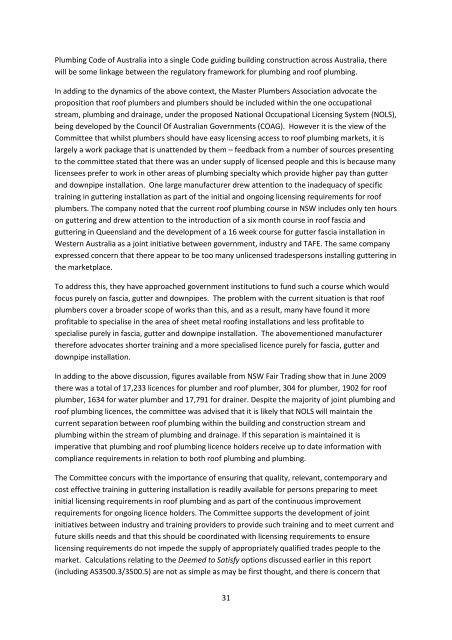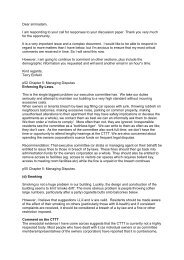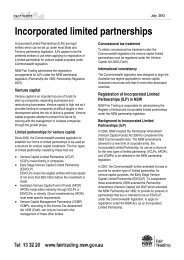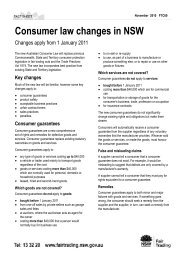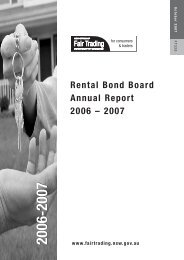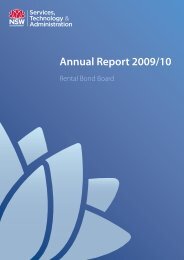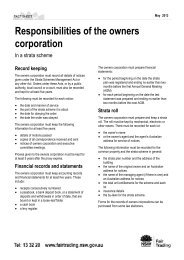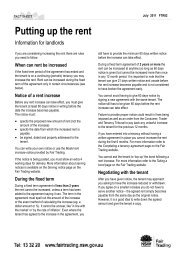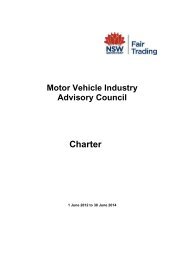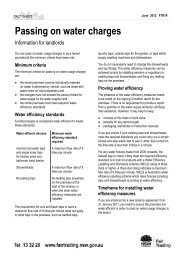High front guttering advisory committee report - NSW Fair Trading ...
High front guttering advisory committee report - NSW Fair Trading ...
High front guttering advisory committee report - NSW Fair Trading ...
Create successful ePaper yourself
Turn your PDF publications into a flip-book with our unique Google optimized e-Paper software.
Plumbing Code of Australia into a single Code guiding building construction across Australia, there<br />
will be some linkage between the regulatory framework for plumbing and roof plumbing.<br />
In adding to the dynamics of the above context, the Master Plumbers Association advocate the<br />
proposition that roof plumbers and plumbers should be included within the one occupational<br />
stream, plumbing and drainage, under the proposed National Occupational Licensing System (NOLS),<br />
being developed by the Council Of Australian Governments (COAG). However it is the view of the<br />
Committee that whilst plumbers should have easy licensing access to roof plumbing markets, it is<br />
largely a work package that is unattended by them – feedback from a number of sources presenting<br />
to the <strong>committee</strong> stated that there was an under supply of licensed people and this is because many<br />
licensees prefer to work in other areas of plumbing specialty which provide higher pay than gutter<br />
and downpipe installation. One large manufacturer drew attention to the inadequacy of specific<br />
training in <strong>guttering</strong> installation as part of the initial and ongoing licensing requirements for roof<br />
plumbers. The company noted that the current roof plumbing course in <strong>NSW</strong> includes only ten hours<br />
on <strong>guttering</strong> and drew attention to the introduction of a six month course in roof fascia and<br />
<strong>guttering</strong> in Queensland and the development of a 16 week course for gutter fascia installation in<br />
Western Australia as a joint initiative between government, industry and TAFE. The same company<br />
expressed concern that there appear to be too many unlicensed tradespersons installing <strong>guttering</strong> in<br />
the marketplace.<br />
To address this, they have approached government institutions to fund such a course which would<br />
focus purely on fascia, gutter and downpipes. The problem with the current situation is that roof<br />
plumbers cover a broader scope of works than this, and as a result, many have found it more<br />
profitable to specialise in the area of sheet metal roofing installations and less profitable to<br />
specialise purely in fascia, gutter and downpipe installation. The abovementioned manufacturer<br />
therefore advocates shorter training and a more specialised licence purely for fascia, gutter and<br />
downpipe installation.<br />
In adding to the above discussion, figures available from <strong>NSW</strong> <strong>Fair</strong> <strong>Trading</strong> show that in June 2009<br />
there was a total of 17,233 licences for plumber and roof plumber, 304 for plumber, 1902 for roof<br />
plumber, 1634 for water plumber and 17,791 for drainer. Despite the majority of joint plumbing and<br />
roof plumbing licences, the <strong>committee</strong> was advised that it is likely that NOLS will maintain the<br />
current separation between roof plumbing within the building and construction stream and<br />
plumbing within the stream of plumbing and drainage. If this separation is maintained it is<br />
imperative that plumbing and roof plumbing licence holders receive up to date information with<br />
compliance requirements in relation to both roof plumbing and plumbing.<br />
The Committee concurs with the importance of ensuring that quality, relevant, contemporary and<br />
cost effective training in <strong>guttering</strong> installation is readily available for persons preparing to meet<br />
initial licensing requirements in roof plumbing and as part of the continuous improvement<br />
requirements for ongoing licence holders. The Committee supports the development of joint<br />
initiatives between industry and training providers to provide such training and to meet current and<br />
future skills needs and that this should be coordinated with licensing requirements to ensure<br />
licensing requirements do not impede the supply of appropriately qualified trades people to the<br />
market. Calculations relating to the Deemed to Satisfy options discussed earlier in this <strong>report</strong><br />
(including AS3500.3/3500.5) are not as simple as may be first thought, and there is concern that<br />
31


